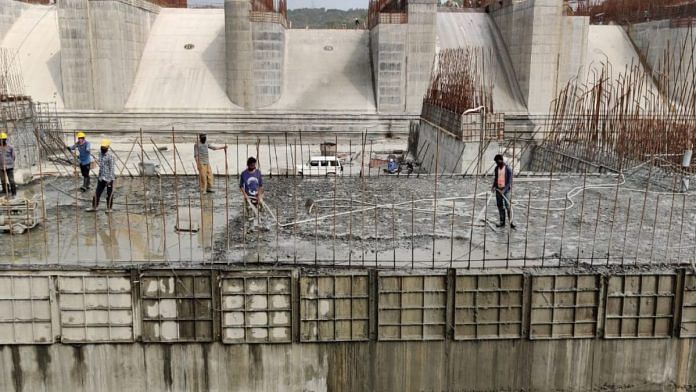India has never resorted to using water as an instrument of war against any country, including Pakistan. But there were compelling reasons to stop the flow of the Ravi waters and direct them to Punjab and Jammu & Kashmir in need of irrigation water. With the completion of Shahpurkandi barrage, the Narendra Modi government has not only answered to the needs of the two states ahead of the general election, but also moved ahead on a promise the prime minister had made in 2016.
“Blood and water can’t flow together,” Modi had told officials of the water resources ministry, calling for punitive action against Pakistan and a review of the Indus Water Treaty of 1960.
Time has come to make that promise a complete reality. The Indus Water Treaty has become redundant and should be junked. Instead, a broad South Asian water-sharing agreement is needed. And that begins by declaring Tibet, the ‘Water Table of Asia’, as a global common, instead of letting it remain a private property of China.
Need to look beyond election
The 1960 treaty allows India to use waters from three rivers in the Indus system—the Ravi, Beas, and Sutlej. After the cowardly 2016 Uri attack on Indian soldiers by Pakistan-based Jaish-e-Muhammad, the Union government faced demands to stop water from Indian rivers flowing into Pakistan. Nitin Gadkari, then-Union Minister for Water Resources, announced plans regarding that, but India resisted provocations to start a water war.
Ignorant of how the Modi government operates, Pakistan’s Deputy Commissioner for Indus Waters, Shiraz Jamil Memon, pooh-poohed India for issuing “empty threats.” The 2019 Pulwama attack gave India more reason to follow through on its promise of preventing Indian river waters from reaching Pakistan.
Previously, water from the Ravi River was flowing from the old Lakhanpur dam through the Madhopur headworks into downstream Pakistan. The proposed barrage could not be built earlier as Punjab and Jammu & Kashmir disagreed on water sharing and costs. First proposed in 1979, the Shahpurkandi barrage was revived in 2001 and 2009 after being declared a “National Project” in 2008. A September 2018 agreement facilitated by the Union government resolved this and work began soon after.
The Shahpurkandi barrage on the Punjab-Jammu and Kashmir border will make 1,150 cusecs of water available for J&K, expected to benefit 32,000 hectares of agricultural land in Kathua and Samba districts.
Although excess monsoon water still flows to Pakistan, this technicality will hardly be noticed during election season. The notion of avenging the Pulwama and Uri attacks by preventing water access to the ‘epicentre of terrorism’ will draw public attention, adding more muscle to the BJP’s strong campaign.
The Shahpurkandi dam gives the BJP a tremendous edge in J&K and Punjab when farmers in both states want more irrigation water. Punjab’s water problem is already serious, with groundwater depletion taking place at a very rapid pace.
Also read: India’s Indus Water Treaty with Pakistan ignored China all along. Time to fix it now
Ignore Pakistan, focus on China
As expected, Islamabad will cry hoarse about the stoppage of water, which it believes is “due to Pakistan” under the 1960 treaty. Despite New Delhi’s best efforts, Pakistan has refused to discuss India’s Kishenganga and Ratle hydroelectric projects for five years, compelling India to issue a notice in January 2023 seeking treaty modifications for the Indus waters’ 20 split favouring Pakistan.
Apart from Pakistan’s treaty obstructionism, there is another reason for India to overhaul the water-sharing agreement and preferably scrap it entirely.
The Indus basin has nine tributaries spanning Afghanistan, India, Pakistan, and Tibet (under Chinese occupation). While the 1960 treaty considers only India and Pakistan, a broad-based treaty should cover all riparian countries and treat the river sources and Tibetan glacial reservoirs as global commons. Glacial melting due to global warming is being accelerated by China’s irresponsible infrastructure projects in Tibet. The upper riparian China’s acts of commission and omission vis-à-vis the Indus basin cannot be overlooked by lower riparian nations and global bodies, which stop short of pontificating on India.
With total control of Tibet, the “Water Tower of Asia”, China has unhindered access to major rivers like the Indus, Brahmaputra (Yarlung Tsangpo in Tibet), Salween, Mekong, and Sutlej, impacting India, Pakistan, Bhutan, Myanmar, Thailand, Laos, Vietnam, and Cambodia. Chinese dam-building on the Indus and Sutlej, besides the Brahmaputra, seriously affects downstream flows.
Civilian water infrastructure and fresh water, as envisaged in the United Nations’ Sustainable Development Goals, is a right of all the lower riparian countries in South Asia. No one country can be entrusted with managing this vital shared resource. India should abrogate the Indus Water Treaty and pitch for a broader South Asian water sharing agreement under its leadership of South-South Cooperation.
Seshadri Chari is the former editor of ‘Organiser’. He tweets @seshadrichari. Views are personal.
(Edited by Prashant)




He is wrong. We have a Ranjit sagar Dam upstream since 2000. New barrage will only help more regulation.
The first priority, and that will take both time and resources, is to make full use of the waters from three rivers assigned to India under the IWT.